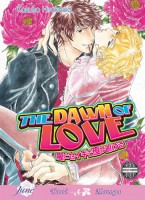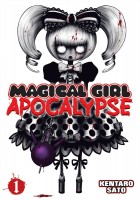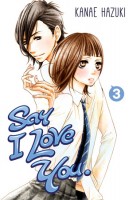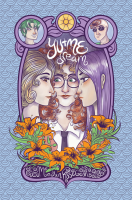My News and Reviews
I posted two reviews at Experiments in Manga last week. First up was my review of Baku Yumemakura and Jiro Taniguchi’s The Summit of the Gods, Volume 4. It’s the penultimate volume in one of my favorite manga series. It was also a particularly intense volume. The fifth and final book should be available sometime next year; I’m really looking forward to it. My second review last week was of Boogiepop Returns: VS Imaginator, Part 1, the second volume in Kouhei Kadono’s Boogiepop light novel series. I didn’t find it to be quite as dark as the first novel, but it still had an interesting mix of science fiction, horror, mystery, and even a bit of romance. I discovered Boogiepop late (the four novels and the four volumes of manga that were translated into English are now out of print) but I’m really enjoying the franchise so far. At this point I definitely plan on checking out the rest of the Boogiepop novels, manga, music, anime series, and live-action film.
On to other things online! Digital Manga has launched its most recent Tezuka Kickstarter project and it is…ambitious. At Manga Comics Manga, Deb Aoki has a nice roundup of some the concerns and criticisms fans have been expressing about the project. Justin has been busy posting more New York Comic Con content at Organization Anti-Social Geniuses, including interviews with Viz Media’s Andy Nakatani (editor-in-chief of Weekly Shonen Jump) and Leyla Aker (Vice President of Publishing). Also, in case you missed it (like I did), Brigid Alverson posted her NYCC interview of Takeshi Obata at Comic Book Resources a couple Fridays back. Ryan Holmberg’s most recent What Was Alternative Manga? column focuses on the proto-gekiga work of Masahiko Matsumoto. The post has great (and probably deliberate) timing—Matsumoto’s The Man Next Door is now available to order from Breakdown Press. Over at Manga Connection, Manjiorin is embarking on a new review project focusing on Crunchyroll’s digital manga. And speaking of manga reviews, Manga Blog’s inagural Bookmarked! feature was posted. I’m very happy to see Manga Blog so active again. Be sure to check it out for its link-blogging, too!
Quick Takes
 The Dawn of Love by Kazuho Hirokawa. Masahiro is infatuated with his fellow law student Takane and so is very happy to discover that Takane, like him, is also gay. Takane has multiple partners which doesn’t bother Masahiro at first, but eventually he decides that he wants Takane to exclusively date him. My biggest issue with The Dawn of Love is that Masahiro uses sex to manipulate Takane, basically forcing Takane to choose monogamy regardless of his own feelings about the matter; it’s really not a good basis for a healthy, long-lasting relationship. I think Hirokawa was trying to going for a sort of “true love conquers all” take with the manga, but The Dawn of Love isn’t successful in achieving that, mostly because I was never convinced that Masahiro and Takane were actually in love to begin with. Even Masahiro doesn’t bother to ask himself why he loves Takane until well into the story, and he never really answers that question. It’s obvious that the two of them enjoy having sex with each other (and there’s a lot of sex in The Dawn of Love), but sexual desire isn’t the same thing as romantic love. The Dawn of Love had great potential and was even rather funny in places, but overall I didn’t end up enjoying it much at all.
The Dawn of Love by Kazuho Hirokawa. Masahiro is infatuated with his fellow law student Takane and so is very happy to discover that Takane, like him, is also gay. Takane has multiple partners which doesn’t bother Masahiro at first, but eventually he decides that he wants Takane to exclusively date him. My biggest issue with The Dawn of Love is that Masahiro uses sex to manipulate Takane, basically forcing Takane to choose monogamy regardless of his own feelings about the matter; it’s really not a good basis for a healthy, long-lasting relationship. I think Hirokawa was trying to going for a sort of “true love conquers all” take with the manga, but The Dawn of Love isn’t successful in achieving that, mostly because I was never convinced that Masahiro and Takane were actually in love to begin with. Even Masahiro doesn’t bother to ask himself why he loves Takane until well into the story, and he never really answers that question. It’s obvious that the two of them enjoy having sex with each other (and there’s a lot of sex in The Dawn of Love), but sexual desire isn’t the same thing as romantic love. The Dawn of Love had great potential and was even rather funny in places, but overall I didn’t end up enjoying it much at all.
 Magical Girl Apocalypse, Volume 1 by Kentaro Sato. I can’t tell for certain yet, but by the end of the first volume of Magical Girl Apocalypse it seems as though the series might actually be a parody. If that’s true, it makes the manga a little more interesting to me. If not, Sato is going to need to do something else to keep my attention. I’m more frightened that Yoruka will have a horrifying back injury due to her ridiculously large breasts than I am of the series’ “zombies.” Despite the inclusion of the creepy-cute magical girls instead of more traditional zombie-like monsters, the manga doesn’t really set itself apart yet. At this point, it somehow feels like a pretty generic zombie story. There’s plenty of disturbing scenes and well-drawn gore, and I appreciate that Sato isn’t afraid to kill off characters who in other series would actually manage to live for more than one chapter, but otherwise I found Magical Girl Apocalypse to be a fairly typical zombie survival manga. The series should be an entertaining read for those fond of the subgenre, and there’s nothing wrong with that, but personally I find myself a little zombied-out these days and prefer my horror to have a little more substance.
Magical Girl Apocalypse, Volume 1 by Kentaro Sato. I can’t tell for certain yet, but by the end of the first volume of Magical Girl Apocalypse it seems as though the series might actually be a parody. If that’s true, it makes the manga a little more interesting to me. If not, Sato is going to need to do something else to keep my attention. I’m more frightened that Yoruka will have a horrifying back injury due to her ridiculously large breasts than I am of the series’ “zombies.” Despite the inclusion of the creepy-cute magical girls instead of more traditional zombie-like monsters, the manga doesn’t really set itself apart yet. At this point, it somehow feels like a pretty generic zombie story. There’s plenty of disturbing scenes and well-drawn gore, and I appreciate that Sato isn’t afraid to kill off characters who in other series would actually manage to live for more than one chapter, but otherwise I found Magical Girl Apocalypse to be a fairly typical zombie survival manga. The series should be an entertaining read for those fond of the subgenre, and there’s nothing wrong with that, but personally I find myself a little zombied-out these days and prefer my horror to have a little more substance.
 Say I Love You, Volume 3 by Kanae Hazuki. One of the things that really impresses me about Say I Love You is Hazuki’s forthright portrayal of teenage sexuality. The characters exhibit both maturity and immaturity in their relationships; they can be surprisingly levelheaded, but they can also let their feelings get the best of them. There’s conflict and selfishness in addition to the beginnings of new love and developing respect for others. The characters and their relationships are believable and have depth to them. The more I read of Say I Love You the more and more like Mei. She, like so many of the other characters, has been hurt in the past, but despite her nervousness and anxiety she’s at a point in her life that she’s able to stand up for herself and for others. (Bullying and dealing with bullies is a recurring theme in Say I Love You.) Though Mei tends not to take crap from other people, she is still vulnerable and she still experiences pain, especially now that she is beginning to open herself up to others again. She’s learning to trust, but it doesn’t always come easily for her. It’s this sort of realistic and layered characterization that Say I Love You does particularly well.
Say I Love You, Volume 3 by Kanae Hazuki. One of the things that really impresses me about Say I Love You is Hazuki’s forthright portrayal of teenage sexuality. The characters exhibit both maturity and immaturity in their relationships; they can be surprisingly levelheaded, but they can also let their feelings get the best of them. There’s conflict and selfishness in addition to the beginnings of new love and developing respect for others. The characters and their relationships are believable and have depth to them. The more I read of Say I Love You the more and more like Mei. She, like so many of the other characters, has been hurt in the past, but despite her nervousness and anxiety she’s at a point in her life that she’s able to stand up for herself and for others. (Bullying and dealing with bullies is a recurring theme in Say I Love You.) Though Mei tends not to take crap from other people, she is still vulnerable and she still experiences pain, especially now that she is beginning to open herself up to others again. She’s learning to trust, but it doesn’t always come easily for her. It’s this sort of realistic and layered characterization that Say I Love You does particularly well.
 YU+ME: Dream, Omnibuses 1-2 by Megan Rose Gedris. I only recently discovered YU+ME, a webcomic that was originally released online between 2004 and 2010. The comic is still freely available to read online, but the series has also now been collected into two omnibuses which include additional content. The first part of YU+ME comes across as a fairly standard girl-meets-girl high school love story. It’s certainly enjoyable, but not an exceptional story on its own. (Although it is noteworthy that the series may have been one of the earliest queer-focused webcomics.) What really makes the YU+ME outstanding is its second part, which places the first half within an entirely new context. Gedris wanted to turn the “but it was all a dream” trope on its head and she does so magnificently. Both the artwork and the storytelling are a bit rough in the beginning, but Gedris steadily improves and by the end the series has turned into something truly spectacular. The first part of YU+ME primarily uses a single art style while the second half explodes into a brilliant variety of design, color, and texture. YU+ME is an epic and surreal lesbian love story with a grand mythos to go along with it and a plot that is much more complex than it first appears.
YU+ME: Dream, Omnibuses 1-2 by Megan Rose Gedris. I only recently discovered YU+ME, a webcomic that was originally released online between 2004 and 2010. The comic is still freely available to read online, but the series has also now been collected into two omnibuses which include additional content. The first part of YU+ME comes across as a fairly standard girl-meets-girl high school love story. It’s certainly enjoyable, but not an exceptional story on its own. (Although it is noteworthy that the series may have been one of the earliest queer-focused webcomics.) What really makes the YU+ME outstanding is its second part, which places the first half within an entirely new context. Gedris wanted to turn the “but it was all a dream” trope on its head and she does so magnificently. Both the artwork and the storytelling are a bit rough in the beginning, but Gedris steadily improves and by the end the series has turned into something truly spectacular. The first part of YU+ME primarily uses a single art style while the second half explodes into a brilliant variety of design, color, and texture. YU+ME is an epic and surreal lesbian love story with a grand mythos to go along with it and a plot that is much more complex than it first appears.
